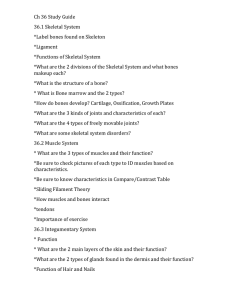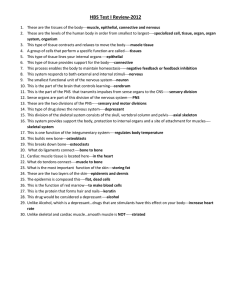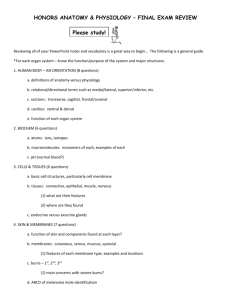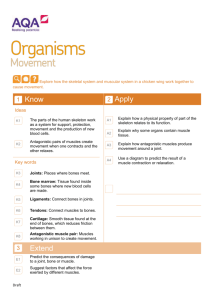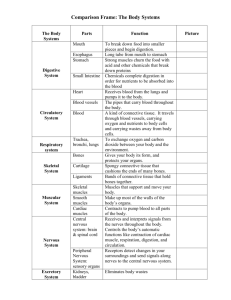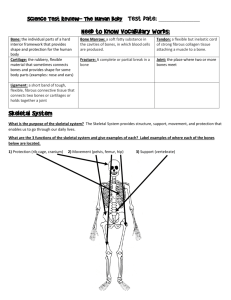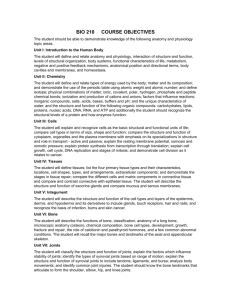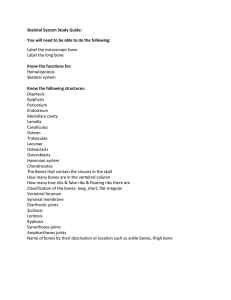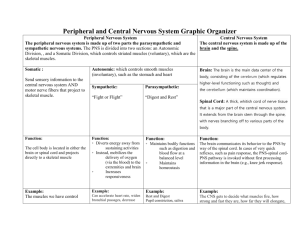Skeletal, Muscular, and Nervous System
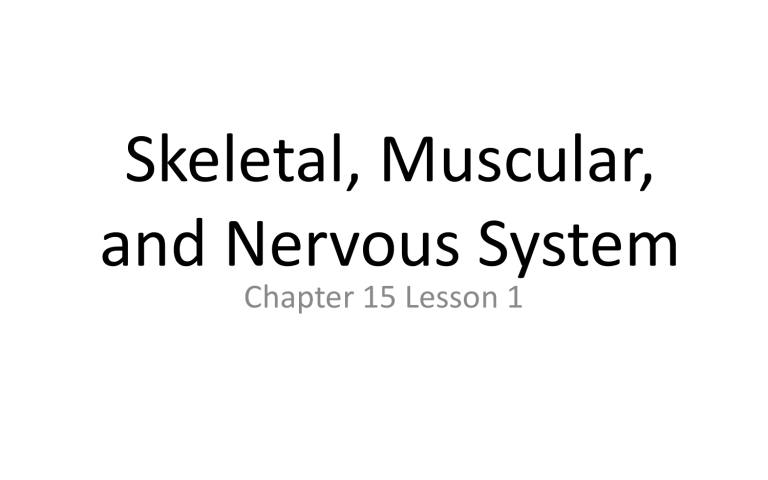
Skeletal, Muscular, and Nervous System
Chapter 15 Lesson 1
W ITH ITS HIGHLY ENGINEERED
JOINTS , THE LIVING SKELETON
PROVIDES A FRAMEWORK OF STIFF
LEVERS AND STABLE PLATES THAT
PERMITS A MULTITUDE OF
MOVEMENTS . I NTIMATELY CONNECTED
WITH THE MUSCULAR SYSTEM , THE
SKELETON ALSO INTEGRATES
FUNCTIONALLY WITH THE
CARDIOVASCULAR SYSTEM EVERY
SECOND MILLIONS OF FRESH BLOOD
CELLS POUR OUT OF THE BONE
MARROW . A HEALTHY DIET THAT
PROVIDES ENOUGH MINERALS ,
ESPECIALLY CALCIUM , ALONG WITH
REGULAR MODERATE EXERCISE CAN
REDUCE THE RISKS OF MANY BONE
AND JOINT DISORDERS .
Skeletal System
•
In this unit we will discuss the 4 main functions of the skeletal system.
•
Movement
•
Protection
•
Cell Production
•
Mineral Storage
Movement
•
The skeletal system plays a crucial role in movement by providing a strong, stable, and mobile framework on which muscles can act.
•
When muscles contract they pull on bones that are attached by tendons .
Tendons
Tendons are tough, fibrous cords of connective tissue that link skeletal muscles to bones.
Protection
•
Your skeletal system protects many vital organs in your body.
•
Example: Your skull bones protect brain tissue from possible damage due to impact
Cell Production
•
Bone Marrow is found in flat bones like the sternum, vertebrea, skull, ribs, and hip bone, and at the ends of long bones. This marrow produces red and white blood cells as well as platelets.
Bone Marrow
•
Bone marrow is soft, fibrous, blood – forming tissue that fills the inner cavities of bones. It produces many types of cells.
•
Platelets always circulate in our bloodstream, looking for tiny tears in blood vessels where blood might leak out, like a paper cut. They accumulate in such cuts during clotting.
•
Red blood cells carry fresh oxygen from the lungs to all the cells that need it, and then carry away the unneeded carbon dioxide.
•
White blood cells are immune responders that combat foreign microorganisms.
Those invaders might cause infection, so white blood cells help produce antibodies that keep the invaders from causing damage.
Storing Minerals
•
Bones store minerals such as calcium and phosphorus.
•
Calcium is "the most abundant mineral in the body." It is necessary for many bodily functions, including "muscle contraction, blood vessel expansion and contraction, secretion of hormones, etc.
Structure of the Skeleton
• Your skeletal system consists of
206 bones that can be classified in two main groups.
Axial
Skeleton
Appendicular skeleton
Axial Skeleton
•
The axial skeleton consists of the
80 bones of the skull, spine, ribs, vertebrae, and sternum.
Appendicular Skeleton
•
The appendicular skeleton is composed of the remaining 126 bones that are not part of the
Axial skeleton
•
Examples: Upper and lower limbs, shoulders, and hips.
Types of Bones
Long Bones
Irregular
Bones
Short
Bones
Flat Bones
Long Bones
• Examples of long bones include the bones in your legs and arms.
• The main column of a long bone is called a diaphysis.
Within the diaphysis is a narrow cavity that contains yellow bone marrow, a type of tissue that stores fat.
• The end of a long bone is called the epiphysis. The epiphyses form joints with other bones and contain red bone marrow, where new blood cells are produced.
Long Bones
Short Bones
• Short bones are almost equal in length and width.
• Examples: Small bones in the wrist and ankle.
Flat Bones
•
Flat bones are somewhat thinner and much flatter the other bones.
•
Examples:
Scapula and skull bones.
Cartilage
•
Cartilage is a strong, flexible connective tissue.
It plays a vital role in your skeletal system. It provides structure and support to the body's other tissues without being as hard or rigid as bone. It can also provide a cushioning effect in joints.
•
There are several types of cartilage including…
Elastic cartilage
(ears, epiglottis )
Hyaline
Cartilage
(joints, ribs, nose)
Fibro cartilage
(intervertebral disks, jaw, knee maniscus)
Skeletal Growth
• An embryo’s skeleton consists mostly of cartilage that serves as a template from which bones will form.
•
Early in embryonic development, the cartilage hardens, this is called ossification.
•
Ossification: the process by which bone is formed, renewed, and repaired.
Ossification
• Joints are points at which bones meet. Some joints move, and other joints don’t.
• The more flexible joints are classified by type.
Joints
Ellipsoidal joints
Ball and socket joints
Pivot joints
Hinge joints
Ball and Socket Joints
• Ball and socket joints are formed when the rounded head of one bone fits into the rounded cavity of an adjoining bone. These joints allow the widest range of motion.
• Examples: Hip or shoulder joints.
Hinge Joints
• Hinge joints are found at the elbow, knee, ankle, and fingers. These joints are like door hinges, they don’t have as much range of motion as the ball and socket joints.
• Pivot joints allow limited rotation or turning of the head.
Pivot joints
Ellipsoidal & Gliding Joints
• Ellipsoidal joints have an ovalshaped part that fits into a curved space.
• Gliding joints allow bones to slide over one another.
Caring for the Skeletal System
Chapter 15 Lesson 2
Care of the Skeletal System
• Caring for your skeletal system is something you can do every day. Eating foods that contain calcium, vitamin D, and phosphorus can help prevent the development of certain skeletal disorders.
Care of the skeletal system
• Regular physical activity, including weight-bearing exercise, helps keep bones strong.
Problems of the skeletal system
Fractures
• A fracture is any type of break in a bone.
Different names are given to fractures because of the way the bone breaks.
• Hairline fracture
• Transverse fracture
• Comminuted fracture
Osteoporosis
• Osteoporosis is a condition in which progressive loss of bone tissue occurs.
• Bones are weakened and become brittle, causing them to break easily.
Scoliosis
• Scoliosis is a lateral, or side to side, curvature of the spine.
• The curvature of the spine worsens as growth continues and may proceed even after growth stops.
• Treatment includes wearing a brace to help straighten the spine and, possible corrective surgery.
• Bursitis results from the inflammation of a fluid-filled sac called the bursa.
• Certain joints, such as the elbow, have bursae that help reduce friction between their movable parts.
Bursitis
Bunions
• A bunion is a bone deformation that causes the big toe to protrude out rather than pointing straight ahead.
• Because of the irregular shape extra pressure is placed on the bursa of the big toe, causing inflammation and pain
• Wearing comfortable shoes may help prevent a bunion from developing.
• Arthritis is the inflammation of a joint. The condition can result from an injury, natural wear and tear, or autoimmune disease.
• The most common form of arthritis, osteoarthritis, results from wear and tear on the joints.
Arthritis
Repetitive Motion Injury
• A repetitive motion injury is damage to tissues caused by prolonged, repeated movements such as in computer work, sewing, or assembly line work.
• One of the most common repetitive motion injuries is carpal tunnel syndrome.
The muscular system
Chapter 15 Lesson 3
Functions of the Muscular System
• Muscles not only aid the skeletal system with movement and protection, it also helps with many of the body's processes.
(Breathing, heart beat, digestion, etc.)
Who has control?
Involuntary
•
Involuntary muscles are those muscles which are not under the control of the will.
You don’t consciously think about digesting food, or making your heart beat, or breathing.
Voluntary
•
Voluntary muscles get messages sent from the brain to control their contraction and relaxation.
Types of Muscles
Smooth Muscle
• Smooth muscles act on the lining of passageways and internal organs.
• Smooth muscles can be found in the lining of the blood vessels, the digestive tract, the passageways that lead into the lungs, and the bladder.
• Smooth muscle are under involuntary control
Skeletal Muscles
• Skeletal muscles are attached to bone and cause body movements.
• Almost all skeletal muscle is under voluntary control
• Skeletal muscles work together, under going opposing actions to produce movement. One muscle contracts while the other muscle extends.
Structure of the Muscular System
• A muscle is made up of hundreds of long cells called fibers.
• Major muscles in the body are made up of hundreds of bundles of these fibers.
Skeletal Muscle Continued…
•
Muscles work together in opposing forces, when one muscle contracts another muscle relaxes.
•
The flexor is the muscle that closes a joint.
•
The extensor is the muscle that opens a joint.
Cardiac Muscle
• Cardiac muscle is a type of striated muscle that forms the wall of the heart.
• The involuntary cardiac muscles are responsible for the contraction of your heart.
Care of the Muscular System
• Regular physical activity is the best way to keep your muscles strong and healthy.
• Muscles that remain unused for long periods of time will atrophy, or decrease in size and strength.
Problems with the Muscular System
Muscular
Dystrophy
Bruise
Hernia
Muscle
Strain
Tendonitis
• A bruise is an area of discolored skin that appears after an injury causes the blood vessels beneath the skin to rupture and leak. Swelling can be reduced with an ice pack
Bruise
Muscle Strain
• A strained muscle results when a muscle is stretched or partially torn as a result of overexertion.
• Strains are usually treated with R.I.C.E.
Strains & Sprains
• Strain: Injury to a muscle
• Sprain: Injury to a ligament
• Most minor injuries can be treated with the rice formula
• R est
• I ce
• C ompression
• E levation
Tendonitis
• Tendonitis is the inflammation of a tendon.
• Signs of tendonitis include joint pain or swelling that worsens with activity.
• A hernia occurs when an organ or tissue protrudes through an area of weak muscle.
• This condition usually results from straining to lift a heavy object. Repair usually requires surgery.
Hernia
Muscular Dystrophy
• Muscular dystrophy is an inherited disorder in which skeletal muscle fibers are progressively destroyed.
• There is no cure, but with early detection muscle weakness can be delayed through exercise programs.
Chapter 15 Lesson 4
The Nervous System
Functions of the Nervous System
• The nervous system is essentially a biological information highway, and is responsible for controlling all the biological processes and movement in the body, and can also receive information and interpret it via electrical signals which are used in this nervous system
2 main divisions of the Nervous system
Central
Nervous
System
(CNS)
Peripheral
Nervous
System
(PNS)
Central Nervous System
• The central nervous system consists of the brain and spinal cord.
• The central nervous system receives messages form the nerves in the peripheral nervous system, interprets them, and sends out a response.
Peripheral Nervous System
• The nerves that run throughout our body that are not part of the CNS are called the peripheral nervous system. They relay information from our brain through our spinal cord to the body, and back again.
•
The nerves in the peripheral nervous system connect the central nervous system to sensory organs (such as the eye and ear), other organs of the body, muscles, blood vessels and glands.
Disc 2 (Sensory
Center)
Neurons
•
A neuron is a nerve cell that is the basic building block of the nervous system.
These highly specialized nerve cells are responsible for communicating information in both chemical and electrical forms.
•
There are several different types of neurons responsible for different tasks in the human body.
Types of Neurons
Sensory Neurons
(Carry information from the sensory receptor cells throughout the body to the brain)
Motor Neurons
(Transmit information from the brain to the muscles of the body)
Interneurons
(Nerve cell found entirely within the central nervous system that acts as a link between sensory neurons and motor neurons)
Parts of a Neuron
A Neuron’s Cell Body
• The cell body of a neuron contains the nucleus, the control center of the cell.
• Unlike other cells in the body, neurons have limited ability to repair damage or replace destroyed cells.
Dendrites
• Dendrites are branched structures that extend from the cell body in most neurons.
• Dendrites receive information from other neurons or sensory receptors and transmit impulses toward the cell body.
• Axons transmit impulses away from the cell body and toward another neuron, muscle cell, or gland.
• Some axons are covered with a myelin sheath and can transmit impulses more quickly than axons without coverings.
Axons
Spinal Cord (CNS)
•
The spinal cord is a long column of nerve tissue.
•
The spinal cord is the main passageway for information between the brain an peripheral nervous system
Spinal Cord Continued…
•
Because spinal cord tissue is vital for survival our bodies have designed multiple levels of protection for it.
•
The 3 substances that protect the spinal cord are…
•
Vertebrae
•
Spinal Meninges
•
Cerebrospinal Fluid
The Brain (CNS)
•
The brain integrates and controls the activities of the nervous system.
•
Your brain helps you receive and process messages: think, remember, and reason; and coordinate muscle movements.
The Brain’s 3 Main Divisions
Cerebrum
Cerebellum
Brain Stem
The Cerebrum
• The cerebrum is the larges and most complex part of the brain.
• The billions of neurons in the cerebrum are the center for conscious thought, learning, and memory.
The cerebrum continued…
• The cerebrum is divided into two hemispheres that communicate with each other.
• The left hemisphere is the center for language, reasoning , and the ability to analyze an think critically about mathematical or scientific problems
• The right hemisphere is the center for processing music and art and comprehending spatial relationships.
The cerebellum
• The cerebellum is the second largest part of the brain. Its principle function is to coordinate the movement of skeletal muscles.
The brain stem
• The brain stem is a three inch stalk of nerves cells and fibers that connects the spinal cord to the rest of the brain.
The Brain Continued…
• Although the brain makes up only about 2 percent of a person’s total body weight, it uses more than 20 percent of the oxygen inhaled.
• Without oxygen, the brain can last for only four to five minutes before suffering serious and irreversible damage.
Protecting the brain
• You should always wear protective equipment when participating in activities that might result in brain injury.
Main Parts of the Brain Stem
Medulla oblongata
Hypothalamus Pons
Thalamus Midbrain
Hypothalamus
• The hypothalamus controls and balances various body processes to regulate body temperature, stimulate appetite for food and drink, and regulate sleep.
• The hypothalamus also control secretion from the pituitary gland that control metabolism, sexual development, and emotional responses.
Parts of the Peripheral Nervous System
• The
Peripheral
Nervous
System can be divided into two categories…
Autonomic
Nervous
System
Somatic
Nervous
System
Autonomic Nervous System
• The autonomic nervous system controls such involuntary functions as digestion and heart rate.
• The autonomic nervous system can be broken down into two smaller networks…
Sympathetic
Nervous System
Parasympathetic
Nervous system
The Sympathetic Nervous System
•
Messages from the sympathetic nervous system cause your heart rate to increase and the blood vessels leading to your muscles to dilate, allowing greater blood flow.
• This is the “fight or flight” response that prepares your body to react to what may be a dangerous situation.
These are reflex actions.
Parasympathetic Nervous System
•
The parasympathetic nervous system is the branch of the autonomic nervous system responsible for returning the body back to a state of balance by reversing the changes caused by the sympathetic nervous system.
Somatic Nervous System
•
The somatic
Nervous System consist of sensory neurons that relay messages from receptors in the eyes, ears, nose, tongue, and skin to the CNS and motor neurons that carry impulses from the CNS to skeletal muscles.
Caring for the Nervous System
• Your health behaviors, such as eating a wellbalanced diet, exercising regularly, and getting enough sleep, affect the health of your nervous system.
Problems with the Nervous System
• Problems with the nervous system can result from damage to nerve cell, or injury to the head or spinal cord. Nerve tissue can also be damaged by degenerative disease.
• Using drugs and alcohol can destroy brain cells and cause nervous system disorder.
Head & Spinal Cord Injuries
• In the united states each year over 1 million people sustain head injuries and an estimated
11,000 new cases of spinal cord injury occur.
Brain protection
•
Like the spinal cord, the brain is covered with layers of cranial meninges and surrounded by a cerebrospinal fluid.
Both of these protect the tissues of the brain from injury.
Head Injuries
• Concussion: Brain injury that causes temporary loss of consciousness.
• Contusion: A bruising of the brain tissues that can result in dangerous swelling.
• A major trauma to the brain can result in a coma, a state of unconsciousness form which a person cannot be awakened.
Spinal Injuries
• Any injury to the spine should be taken seriously.
• Swelling of the spinal cord or the tissue around it in response to trauma can result in the temporary loss of nerve function.
• If the spinal cord has been severely damaged beyond repair, paralysis usually result.
Spinal Injuries Continued…
• An injury to the upper part of the spinal cord may result in
Quadriplegia which is a paralysis of both upper and lower limbs.
• An injury to the lower part of the spinal cord may cause Paraplegia which is a paralysis of both lower limbs.
,
Degenerative Diseases
• Degenerative diseases cause affected cells and tissues to break down or deteriorate over time.
• Listed are diseases that affect the nerves of the nervous system
Epilepsy
Parkinson’s
Disease
Alzheimer’s
Disease
Multiple
Sclerosis
Parkinson’s Disease
• Parkinson’s disease results in the destruction of nerve cells in an area of the brain that helps coordinate skeletal muscle movement.
•
As cells are destroyed, muscle function is impaired.
Symptoms may include uncontrolled muscle tremors or increased muscle rigidity.
There is no cure at this time.
Multiple Sclerosis
• Multiple sclerosis involves the destruction of the myelin sheath that surrounds the axons of neurons in the CNS.
• The scar tissue that remains on the neuron interferes with the conduction of nerve impulses, and voluntary control of muscles gradually decreases.
Alzheimer’s Disease
• Alzheimer’s disease results when neurons become tangled or clogged with protein deposits. This means the neurons are unable to transmit impulses.
• Symptoms of Alzheimer's are confusion, loss of memory, and gradual metal retardation.
Epilepsy
• Epilepsy is a disorder that causes seizures.
• Seizures are sudden episodes of uncontrolled electrical activity in the brain.
• Epilepsy can be caused by many factors: Brain damage, infection, drug withdrawal, etc.
• Medications can help control seizures.
